Research News
- Nature-inspired Seagull Optimisation Approach algorithm July 12, 2022
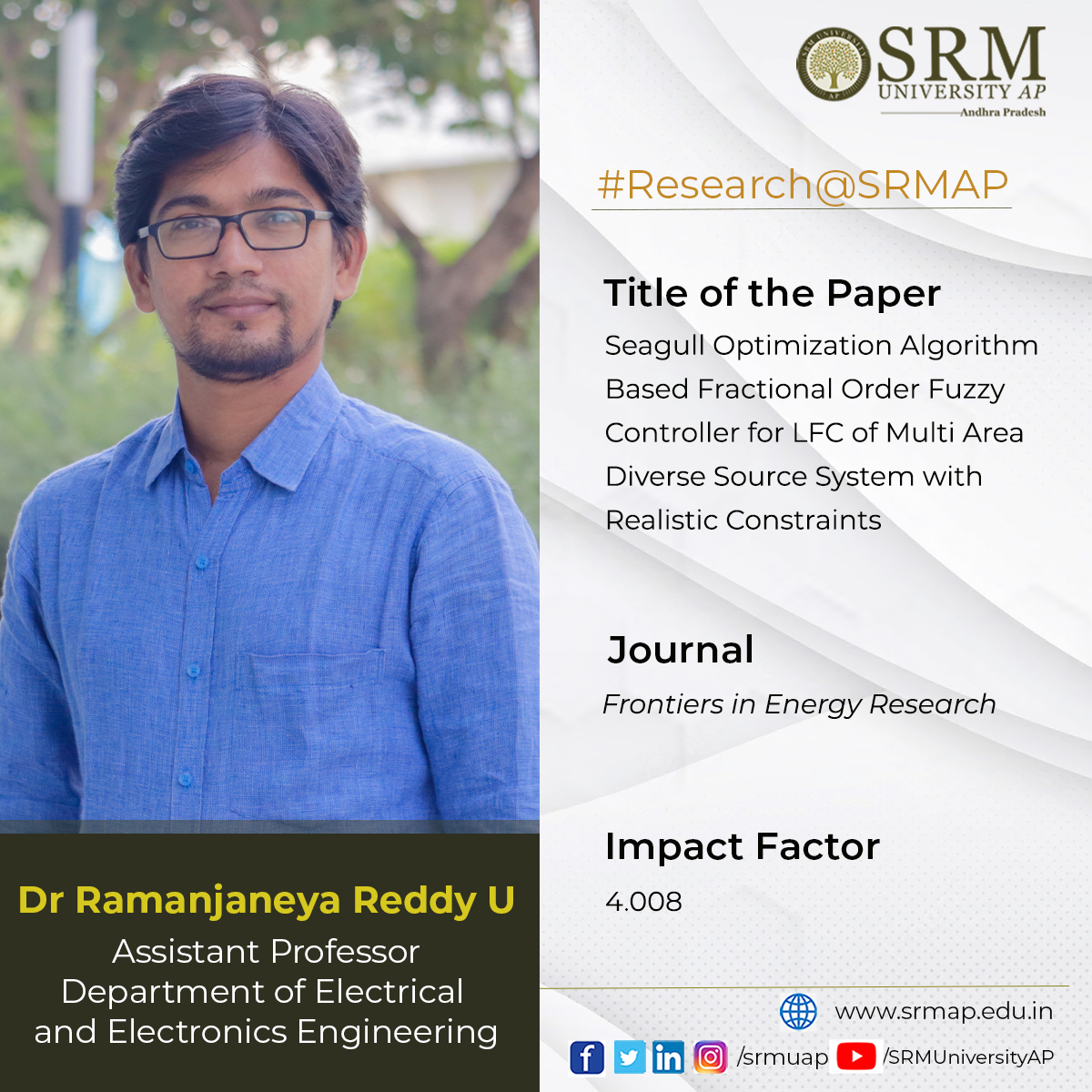 In modern days, the most potent ancillary service is the LFC, especially for controlling and operating interconnected power system networks. The electrical system is becoming more complex due to the integration of several diverse sources generating units to meet the variable load demand. Research in the Department of Electrical and Electronics Engineering is currently working on this area. Assistant Professor Dr Ramanjaneya Reddy recently published a paper titled Seagull Optimization Algorithm Based Fractional Order Fuzzy Controller for LFC of Multi Area Diverse Source System with Realistic Constraints in the Frontiers in Energy Research journal. It is published in the Smart Grids section of the journal with an impact factor of 4.008.
In modern days, the most potent ancillary service is the LFC, especially for controlling and operating interconnected power system networks. The electrical system is becoming more complex due to the integration of several diverse sources generating units to meet the variable load demand. Research in the Department of Electrical and Electronics Engineering is currently working on this area. Assistant Professor Dr Ramanjaneya Reddy recently published a paper titled Seagull Optimization Algorithm Based Fractional Order Fuzzy Controller for LFC of Multi Area Diverse Source System with Realistic Constraints in the Frontiers in Energy Research journal. It is published in the Smart Grids section of the journal with an impact factor of 4.008.Abstract
This paper initiates the implementation of fractional order (FO) fuzzy (F) PID (FOFPID) controller fine-tuned using a seagull optimisation algorithm (SOA) for the study of load frequency control (LFC). Initially, the SOA tuned FOFPID regulator is implemented to the widely utilized model of dual area reheat-thermal system (DARTS) named as test system-1 in this work for a perturbation of 10% step load (10%SLP) on area-1. Dynamical analysis of the DARTS system reveals the viability of SOA tuned FOFPID control scheme in regulating frequency deviations effectively compared to other control schemes covered in the literature. Later, the presented regulator is implemented in multi-area diverse sources (MADS) system possessing realistic constraints in this paper termed test system-2. The sovereignty of the presented FOFPID controller is once again evidenced with controllers of PID/FOPID/FPID fine-tuned with the SOA approach. Moreover, the effect of considering practical realistic non-linearity constraints such as communication time delays (CTDs) on MADS system performance is visualized, and the necessity of its consideration is demonstrated. Further, AC-DC lines are incorporated with MADS system to enhance the performance under heavy load disturbances and the robustness of the proposed regulatory mechanism is deliberated.
Explanation of the research
The operating point of the generation unit must be altered to keep the real power mismatch (RPM) as minimum as possible. RPM is the exact difference between the amount of real power generated by the generation units and the existing load demand. This RPM is the direct analogy to one of the power full parameters in the interconnected network, frequency. Thus, the minimisation of RPM should be monitored continuously as there will be continuous fluctuations in load demand. This must be done automatically. Otherwise, the real power mismatch may worsen and affect the power system frequency. Frequency regulation must be made with the utmost care; if not, it adversely affects the power system stability. LFC will quickly and automatically accomplish this task.
From the literature on LFC, it is apparent that the optimisation-based controllers significantly handle LFC performance. Hence, applications of new optimisation algorithms for solving realistic power system problems are always welcome. In this regard, this paper implements a new nature-inspired seagull optimisation approach (SOA) algorithm. It is a maiden attempt, especially for power system operation and control of IPS with practical constraints. Until now, the regulators presented by the researchers are tested on linearised and non-linearised power system models without and with integrating renewable energy units. To authenticate the investigative analysis of LFC closer to the nature of the realistic practice, the researchers must adopt the non-linearity constraints with power system models. Constraints of non-linearity like GRC and GDB are considered widely by the researchers and paid less attention to other constraints of CTDs.
In realistic practice, IPS are widely spread and employs numerous sensing and phasor measurement devices. The measured data will be transmitted and received among different devices located at distant places via communication peripherals. Exchange of information won’t be done instantly, and a specific time delay exists. The delay might affect the IPS performance; hence, this paper tried to investigate the predominancy of time delays in coordination with the constraint of GRC. Little work is available on studying LFC with CTDs and is restricted up to the implementation of traditional regulators. Thus, this paper addresses the impact of realistic constraint parameter that is CTDs on IPS performance in coordination with GRC under fuzzy aided FO-based regulator based on the newest optimization algorithm.
Practical implementations of the research
This work considered two different power system networks to assess the FOFPID controller performance. One is DARTS, termed test system-1, and the other is MADS, termed test system-2. DARTS model incorporates thermal units of reheat-type turbines in both areas with equal generation capacities. On the other hand, the MADS system that tests system-2 consists of two areas having Thermal-Hydro-Gas units in area-1, and area-2 comprises Thermal-Hydro-Wind units. The participation factor for each source of generation unit is allocated to achieve smooth load distribution and is considered as 0.6225 for thermal, 0.3 for hydro unit, and a factor of 0.075 for gas/wind unit. The required data to build the DARTS system depicted in Figure 1 and MADS system model depicted in Figure 2 are considered from [13] and [35], respectively. The power system models are designed in the (R2016a) version of MATLAB/SIMULINK.
In the future, there is a lot of scope for assessing the effect of CTDs on LFC performance and the implementation of SOA-based FOFPID for optimising IPS in the restructured environment.
Continue reading → - Highly stable ruthenium catalyst for hydrogen evolution reaction July 12, 2022

The Department of Physics is glad to announce that Prof Ranjit Thapa and his PhD scholar, Mr Samadhan Kapse, have published a patent titled “Highly Stable Ruthenium Single-Atom Catalysts on Fe3O4/MWCNTs for Hydrogen Evolution Reaction” (Application no. 202241006087). The research was done in collaboration with Ms Shwetha K R, Mr Shivanna M and Dr Nagaraju D H, from the Department of Chemistry, School of Applied Sciences, REVA University, Bangalore.
A Brief Description of the Research
In the current work, Fe3O4 nanoparticles were prepared by a simple chemical co-precipitation method under an inert atmosphere, and it was utilised for HER studies. Ru nanoparticles were profitably deposited over Fe3O4/MWCNTs modified glassy carbon electrode by the electrochemical deposition technique. The superior HER activity was achieved on Fe3O4/MWCNTs/Ru in 0.1M H2SO4 aqueous media. We demonstrated that synthesised electrocatalyst offers low over potential 101 mV to reach a current density of 10 mA cm-2 towards hydrogen evolution reaction. It displays exceptional stability and finds to be of no change in the HER activity despite 1000 cycles. It is emphasised that a small weight percentage of ruthenium in the prepared catalyst can replace high-cost platinum in renewable energy technologies.
Social Implications of the Research
Production of renewable energy has greater significance in the present situation owing to the impact of the depletion of non-renewable energy resources such as fossil fuels and the release of greenhouse gases into the atmosphere. Hydrogen has gained considerable interest as an energy storage and energy carrier due to its high energy density (146kJ/g), and its utilisation also eliminates pollution and toxicity. Several methods have been explored to produce molecular hydrogen. Among them, the electrolysis of water is the best way to produce high purity hydrogen from water. An excellent electrocatalyst is obligatory to liberate hydrogen gas effectively from water. It is known that Superior HER activity has been achieved using platinum (Pt) and Pt-based catalysts. Due to its high cost and low surplus, its expansion has been limited to the industrial scale. The research proposes that Ru-based catalysts can overcome these challenges.
DFT study is more effective to find the origin of catalytic activity in materials for designing highly promising catalysts for various catalytic reactions. The researchers expressed their gratitude to SRM University-AP for providing the required computational facility and support.
Continue reading → - Delay-Tolerant IoT enabled smart agriculture system July 12, 2022

Agricultural development is one of the powerful tools to boost the economy of any developing country. The recent advancement of IoT-based smart agriculture systems helps to achieve more productivity with relatively less overhead. The Department of Computer Science and Engineering is glad to announce that their faculty; Dr Sobin CC, Associate Professor; Dr Sonam Maurya, Assistant Professor; and Dr Amit Kumar Singh, Assistant Professor; have published a patent titled “Smart Agriculture System using Delay Tolerant Internet of Things” (Application No. 20224102799), a framework for smart agricultural applications using Delay Tolerant Internet of Things (DT-IoT) which can handle the issues related to disruptions in network connectivity.

The inherent limitations of IoT-based smart agriculture systems majorly in terms of resource constraints, frequent network disconnections and vulnerability to many attacks may affect their advantages over the traditional systems. The application using DT-IoT, with access to greater network connectivity can deliver relevant data in real-time. Furthermore, the stored data can be processed and analysed to help farmers in making critical decisions related to their farm filed. Hence, their innovation focuses on designing and developing a prototype for a smart agricultural application using the Internet of Things (IoT).
One of the simplest outcomes of providing smart agricultural solutions for remote villages in India will be greater support to the farmers to improve their productivity and better decision-making in cultivation. But advanced technologies need Internet connectivity in the field to function, which is still a dream in many of the remote villages in India. The lack of proper communication facilities faces off the application of IoT networks. This fact has motivated them to propose a smart agricultural system to work on agricultural application issues using delay-tolerant characteristics. The use of delay-tolerant features in traditional IoT provides a solution for smart agriculture which can handle issues related to disruptions in connection to improve communications.
Another important aspect is that many of the applications, including IoT/Sensor networks, are either simulation-based or experimental. A very few of the applications are developed and implemented in the real-time field for the benefit of farmers in remote villages. In most of the remote villages in India, most of the farmers are poor, many of them are even without primary school education and they rely mostly on traditional agricultural practices which they received from their previous generations. Therefore, their study proposed to test and implement the smart agricultural system with real-time automated solutions related to irrigation, controlled fertilisation, cultivation, production quality, quantity, crop health etc. using IoT with delay-tolerant support. They are also in the process of collaborating with academia and industry to execute this project.
Social Implications
- Proposed smart agriculture system will assist in real-time monitoring of farm field conditions, like irrigation, soil quality, and nutrient deficiency.
- It provides support to farmers to improve their productivity and decision-making in crop cultivation.
- The proposed system will provide optimization in terms of seed selection, resource utilisation, planning cultivation, marketing, harvest quality, etc., using Machine Learning techniques.
- Agricultural field data analysis (for data collected by the large group of sensors) and its visualisation.
- Weather prediction (for better planning).
- Price prediction (for better marketing strategies).
Fig 1: Main components of the proposed Smart Agriculture System
Fig 2: Illustration of 3-level architecture implementation in the Smart Agriculture System
Continue reading → - Published the 5th consecutive article in the American Chemical Society July 11, 2022
The Department of chemistry has always been a dynamic space for innovative and inspiring research. Recently, Assistant Professor Dr Nimai Mishra published his fifteenth research paper from SRM university-AP as a corresponding author. The paper is titled Post-synthesis Treatment with Lead Bromide for Obtaining Near Unity Photoluminescence Quantum Yield and Ultra-Stable Amine Free CsPbBr 3 Perovskite Nanocrystal and is published in the Q1 journal, The Journal of Physical Chemistry C with an impact factor of 4.2. The research group is comprised of Dr Mishra’s PhD students Mr Syed Akhil, Dr V G Vasavi Dutt, and Mr Rahul Singh. This is the group’s fifth consecutive article published in the American Chemical Society.
About the article
 The article reports Ultra-Stable and Near Unity Photoluminescence Quantum Yield Amine Free CsPbBr 3 Perovskite Nanocrystal Post-synthesis Treatment with Lead Bromide. Herein, the researchers have introduced a simple lead bromide (PbBr 2 ) post-treatment process to achieve the near-unity PLQY (>95 %) in amine-free CsPbBr 3 PNCs. Furthermore, PbBr 2 treatment enables these materials to drastically improve stability in different environmental conditions (polar solvents, light, and heat). In addition, a green-emitting down- converted light-emitting diode was fabricated using PbBr 2 treated amine-free CsPbBr 3 PNCs, which shows its considerable prospects for display applications. Thus, the results of the research will promote these PbBr 2 treated amine-free inorganic perovskite nanocrystals for commercial development in optoelectronic applications.
The article reports Ultra-Stable and Near Unity Photoluminescence Quantum Yield Amine Free CsPbBr 3 Perovskite Nanocrystal Post-synthesis Treatment with Lead Bromide. Herein, the researchers have introduced a simple lead bromide (PbBr 2 ) post-treatment process to achieve the near-unity PLQY (>95 %) in amine-free CsPbBr 3 PNCs. Furthermore, PbBr 2 treatment enables these materials to drastically improve stability in different environmental conditions (polar solvents, light, and heat). In addition, a green-emitting down- converted light-emitting diode was fabricated using PbBr 2 treated amine-free CsPbBr 3 PNCs, which shows its considerable prospects for display applications. Thus, the results of the research will promote these PbBr 2 treated amine-free inorganic perovskite nanocrystals for commercial development in optoelectronic applications.Explanation of the research
Cesium lead halide perovskite nanocrystals (PNCs) have been the flourishing area of research in the field of photovoltaic and optoelectronic applications because of their excellent optical and electronic properties. Mainly, cesium lead bromide (CsPbBr 3 ) NCs with bright green photoluminescence (PL) and narrow full-width at half-maximum (FWHM) of < 25 nm is the most desirable for television displays and green-emitting LEDs. Improving the photoluminescence quantum yields (PLQYs) and optimizing the stability have been challenging tasks to promote cesium lead halide (CsPbX3; X=Cl, Br and I) perovskite nanocrystals (PNCs) for real optoelectronic applications. In recent years, the amine- free synthesis route has become an option for making stable CsPbX 3 PNCs.
Continue reading → - Reverse carry select adder and graphene-based field-effect transistor July 5, 2022
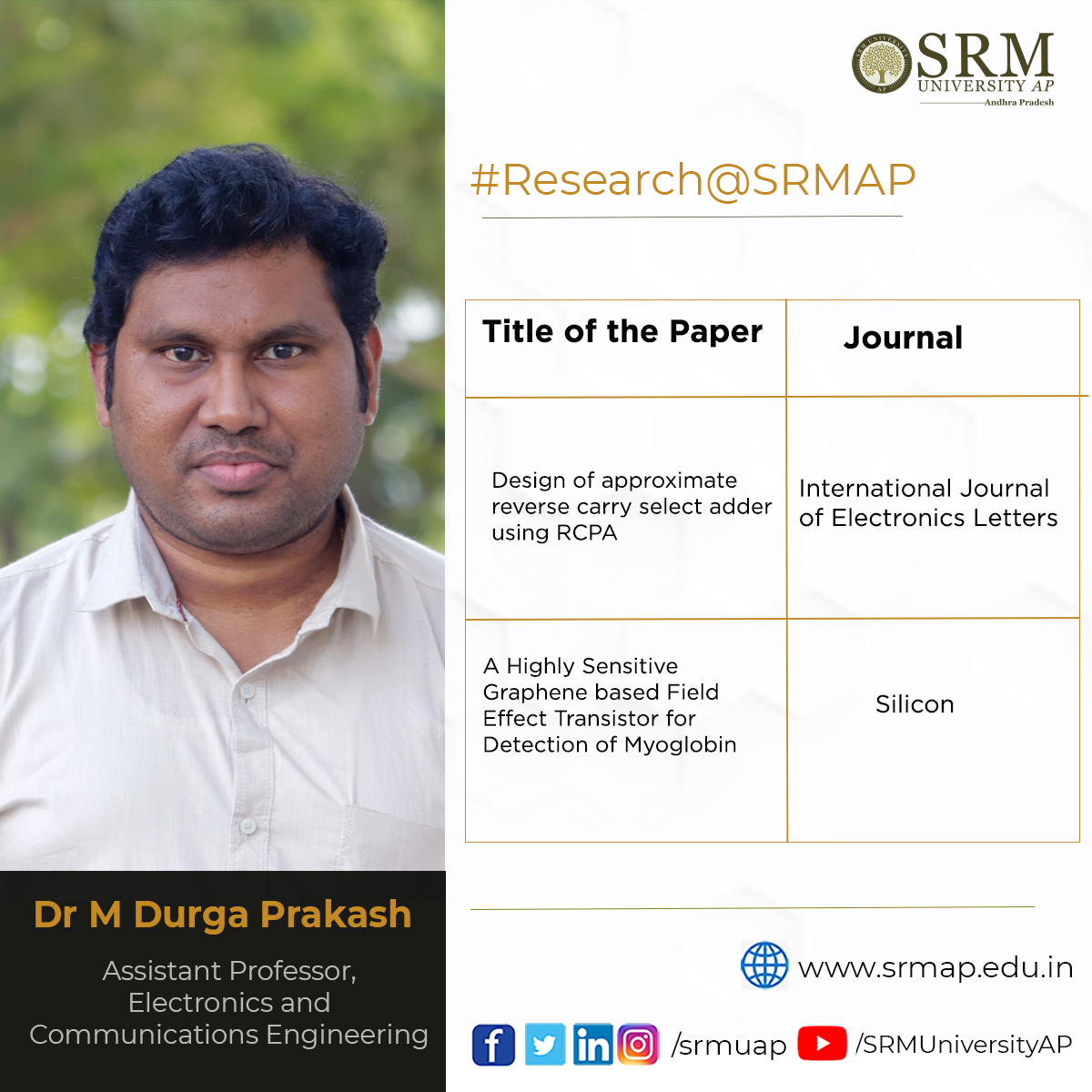 By publishing two papers in well-acclaimed research journals, Assistant Professor Dr M Durga Prakash of the Department of Electronics and Communication Engineering is expanding the possibilities of his research domain through innovative ideas. The first paper was published in the International Journal of Electronics Letters, an internationally renowned peer-reviewed rapid communication journal. It is titled Design of approximate reverse carry select adder using RCPA and has an impact factor of 1.5.
By publishing two papers in well-acclaimed research journals, Assistant Professor Dr M Durga Prakash of the Department of Electronics and Communication Engineering is expanding the possibilities of his research domain through innovative ideas. The first paper was published in the International Journal of Electronics Letters, an internationally renowned peer-reviewed rapid communication journal. It is titled Design of approximate reverse carry select adder using RCPA and has an impact factor of 1.5.Abstract
An approximate carry select adder (CSLA) with reverse carry propagation (RCSLA) is shown in this work. This RCSLA was designed with a reverse carry propagate full adder (RCPFA). In the RCPFA structure, the carry signal propagates in the reverse direction, that is, from MSB part to LSB part, then the carry input has greater importance compared to the output carry. Three types of implementations were designed in RCPFA based on the design parameters. This method was applied to RCA & CSLA to design other types of approximate adders. These designs and simulations were done in CADENCE Software tool with 45 nm COMS technology. The design parameters of the three CSLA implementations with RCPFA are compared with the existing CSLA adders.
The other paper, A highly sensitive graphene-based field-effect transistor for detection of myoglobin, has been published in the Silicon Journal, an international and interdisciplinary journal, with an impact factor of 2.67.
Abstract
Biomedical applications adapt Nanotechnology-based transistors as a key component in the biosensors for diagnosing life-threatening diseases like Covid-19, Acute Myocardial Infarction (AMI), etc. The proposed work introduces a new biosensor, based on the Graphene Field Effect Transistor (GFET), which is used in the diagnosis of Myoglobin (Mb) in human blood. Graphene-based biosensors are faster, more precise, stronger, and more trustworthy. A GFET is created in this study for the detection of myoglobin biomarker at various low concentrations. Because graphene is sensitive to a variety of biomarker materials, it can be employed as a gate material. When constructed Graphene FET is applied to myoglobin antigens, it has a significant response. The detection level for myoglobin is roughly 30 fg/ml, which is quite high. The electrical behaviour of the GFET-based biosensor in detecting myoglobin marker is ideal for Lab-on-Chip platforms and Cardiac Point-of-Care Diagnosis.
Continue reading → - Dr Pankaj Pathak published articles on sustainable waste management July 2, 2022
Dr Pankaj Pathak from the Department of Environmental Science has been keenly involved in research studies involving solid waste management and the effective conversion of wastes to energy. Her latest research publication ‘A comprehensive review on integrative approach for sustainable management of plastic waste and its associated externalities’ in the journal Science of the Total Environment (Impact Factor: 10.973) proposes enhanced solution for the sustainable management of plastic wastes. The article was published in collaboration with her PhD Scholar MSSR Tejaswini, Prof Sreeram Ramakrishna from the Centre for Nanofibers and Nanotechnology, National University of Singapore and Dr P Sankar Ganesh from BITS Pilani, Hyderabad.
Abstract of the Research
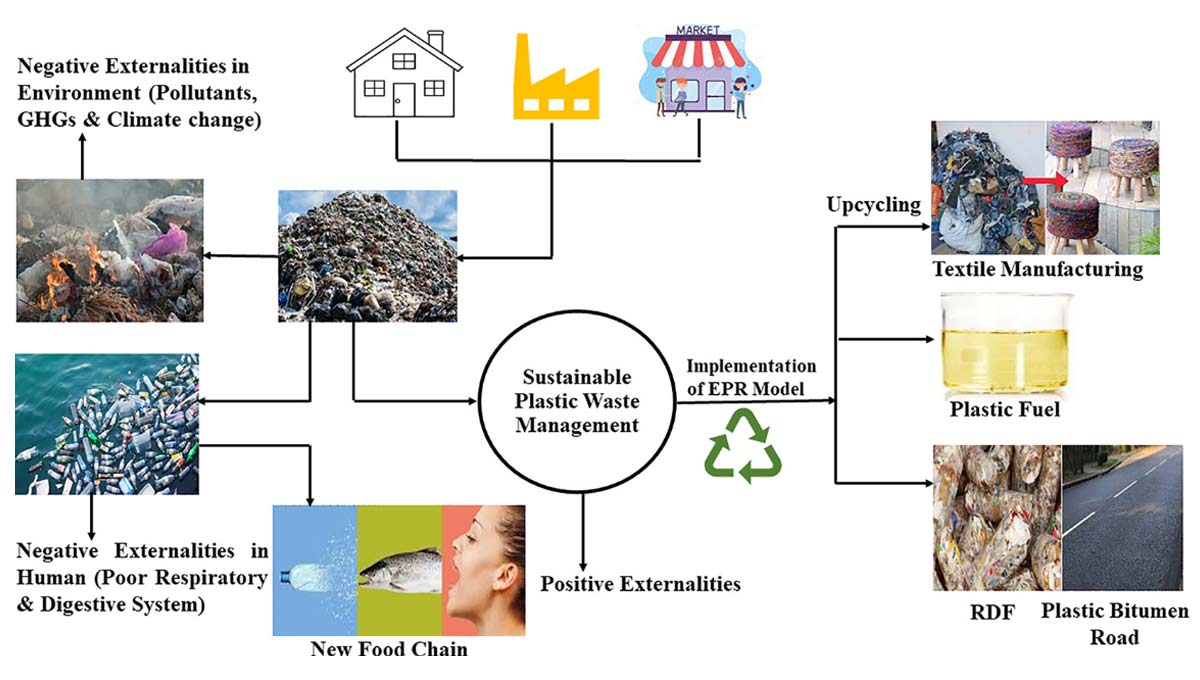
The management of post-consumer discarded plastic wastes (PCPW) creates new challenges in developing countries due to the lack of amenities, technological interventions, and associated negative environmental externalities. The fate of untreated recyclable and non-recyclable plastic wastes lies in open dumping along with other solid waste, and improper management leads to environmental externalities such as pollution, global climate change, and health issues. Additionally, open dumping upsurges the emerging microplastics and nano plastics (MNPs) contaminants. The externalities depend on the waste generating sources (household, industries, commercial), waste composition, and its characteristics. However, urban mining can minimize environmental externalities where waste plastics can convert into potential anthropogenic resources and also helps in achieving the target of sustainable development goals (SDGs 11 & 12). Moreover, various treatment technologies that help in the sustainable utilization of plastic wastes are extensively reviewed in this study and evaluate the costs benefits arising during various stages of treating plastic waste through recycling (R), incineration (I), and landfilling (L). The recycling of plastic waste has demonstrated the lowest impact on global warming potential (GWP) and total energy use (TEU), followed by landfilling and incineration (R < L < I). Nevertheless, when energy is recovered from inert (non-recyclable) plastic waste in the form of fuel or by its utilization in construction purposes, the environmental impacts are more negligible (Incineration < Landfilling). Therefore, this study determines the significance of circular economy with legislative approach and standards on plastic waste management, which help in reducing environmental externalities besides yielding a secondary resource as energy and materials through urban mining. A sustainable plastic waste management (SPWM) model is proposed for developing countries to convert plastic waste into resources and use it as a sustainable tool in urban mining.
Yet another article, ‘Comprehensive technological assessment for different treatment methods of leather tannery wastewater’, co- published by Dr Pankaj Pathak along with a group of other researchers was featured in the journal Environmental Science and Pollution Research having an Impact Factor of 5.19. The work offers some exhaustive observations and recommendations that could be helpful in the industry to manage tannery wastewater and recirculate the water in a sustainable manner.
Abstract of the Research
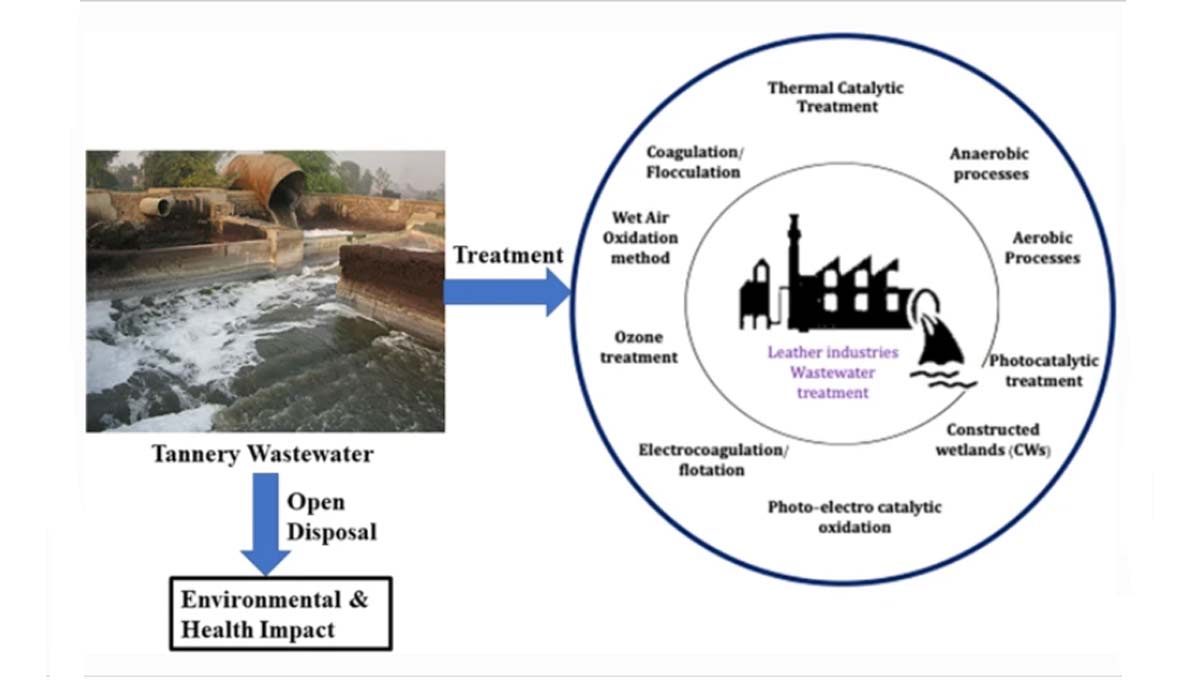
The leather-making process necessitates large amounts of water and consequently generates tons of liquid waste as leather tannery wastewater (TWW) is disposed of directly in the open environment. Open disposal of untreated TWW into the natural environment causes an accumulation of various polluting compounds, including heavy metals, dyes, suspended solids inorganic matter, biocides, oils, tannins, and other toxic chemicals. It thus poses potential hazards to the environment and human health. This study primarily focuses on providing in-depth insight into the characteristics, treatment strategies, and regulatory frameworks for managing TWW in leather processing industries. Different technologies of conventional physico-chemical (equalization, coagulation, and adsorption), advanced approaches (Fenton oxidation, ozonation, cavitation), thermo-catalytic and biological treatments available to treat TWW, and their integrative approaches were also highlighted. This review also sheds light on the most frequently applied technologies to reduce contaminant load from TWW though there are several limitations associated with it such as being ineffective for large quantities of TWW, waste generation during treatment, and high operational and maintenance (O&M) costs. It is concluded that the sustainable alternatives applied in the current TWW technologies can minimize O&M costs and recirculate the treated water in the environment. The exhaustive observations and recommendations presented in this article are helpful in the industry to manage TWW and recirculate the water in a sustainable manner.
- Hybrid relay – IRS-aided wireless IoT network for 6G communications July 1, 2022
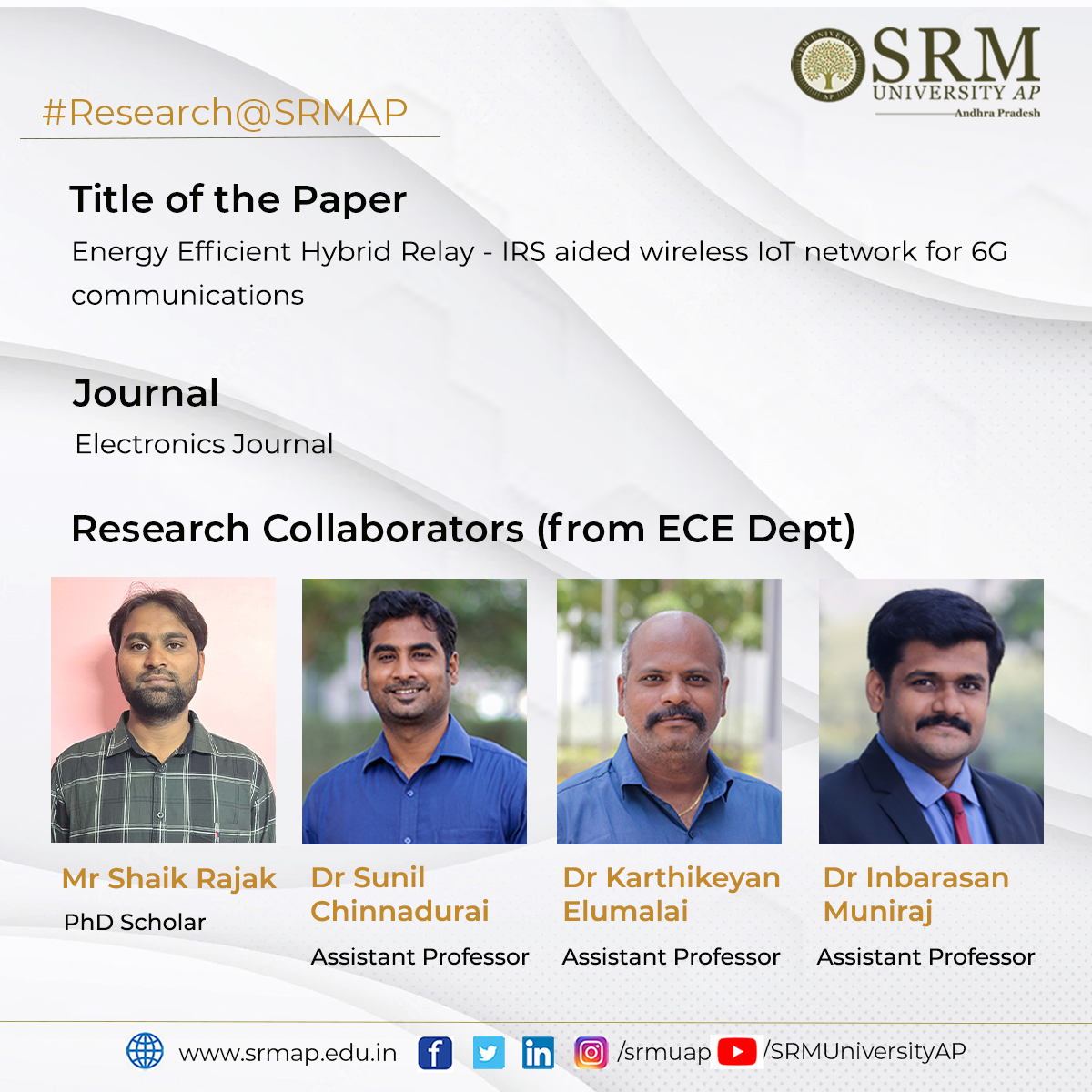
The Department of Electronics and Communication Engineering has come out with yet another rewarding publication, “Energy-Efficient Hybrid Relay – IRS aided wireless IoT network for 6G communications”, in the Electronics Journal, with Impact Factor 2.4. The article was published by Mr Rajak Shaik, PhD Scholar, in collaboration with the faculty members; Dr Sunil Chinnadurai, Dr Karthikeyan Elumalai and Dr Inbarasan Muniraj. This research is the first of its kind, which examines and compares the impact of relay-aided, IRS-aided, and novel hybrid relay-IRS-aided wireless IoT networks for 6G communications in terms of Energy Efficiency.
The article examines Energy Efficiency as a function of user distance and various SNR (Signal-to-noise ratio) values. The Energy Efficiency with fixed and varying numbers of IRS elements is analysed for the proposed IoT network. The results show that the proposed hybrid relay-IRS-assisted IoT network outperforms both the conventional relay and IRS-aided wireless IoT networks. The hybrid relay-IRS-aided IoT network can fulfil the requirements of high data rate, reliable data transfer, and large bandwidth needed for 6G communications. The multiple IRS concept can also be used in 6G communications at high SNR values to reduce both the cost and additional power consumption of wireless IoT networks. Their future research plan also includes the real-time implementations to improve the energy efficiency for wireless IoT networks with IRS in 6G communications.
Abstract of the Research
Intelligent Reflecting Surfaces (IRS) have been recognized as presenting a highly energy-efficient and optimal solution for future fast-growing 6G communication systems by reflecting the incident signal towards the receiver. A large number of Internet of Things (IoT) devices are distributed randomly in order to serve users while providing a high data rate, seamless data transfer, and Quality of Service (QoS). The major challenge in satisfying the above requirements is the energy consumed by the IoT network. Hence, in this paper, we examine the energy efficiency (EE) of a hybrid relay-IRS-aided wireless IoT network for 6G communications. In our analysis, we study the EE performance of IRS-aided and DF relay-aided IoT networks separately, as well as a hybrid relay-IRS-aided IoT network. Our numerical results showed that the EE of the hybrid relay-IRS-aided system has better performance than both the conventional relay and the IRS-aided IoT network. Furthermore, we realized that the multiple IRS blocks can beat the relay in a high SNR regime, which results in lower hardware costs and reduced power consumption.
Continue reading → - Two paper presentations at the 4th International Conference on Energy, Power, and Environment July 1, 2022
Two research papers from the Department of Computer Science and Engineering were presented at the 4th International Conference on Energy, Power, and Environment held from April 29 to May 1, 2022. Assistance professor V M Manikandan and three BTech students participated in the conference organised by NIT Meghalaya, India. The papers will be published in IEEE Xplore Digital Library (Scopus Indexed).
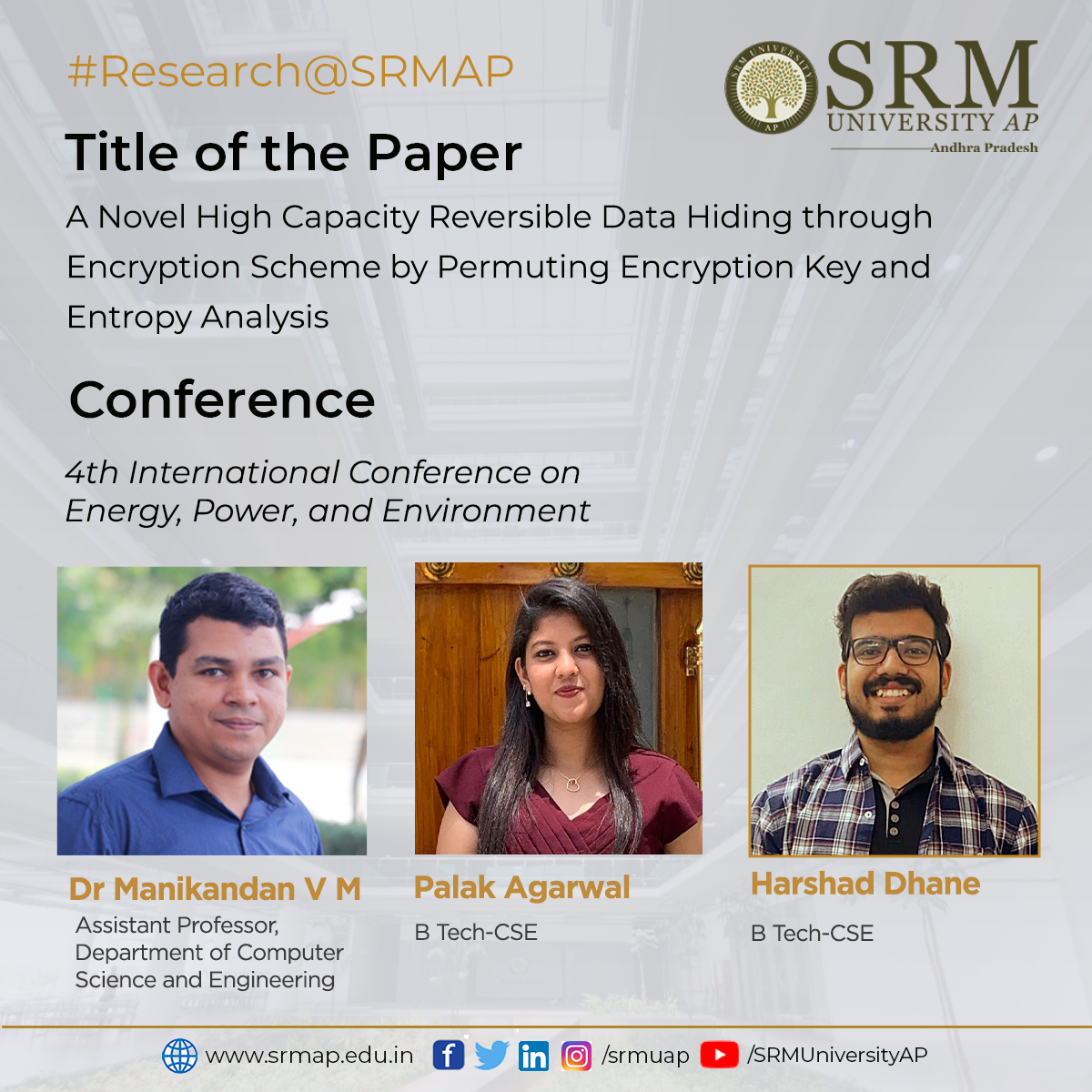 Third-year BTech CSE student Harshad Dhane presented the paper A Novel High Capacity Reversible Data Hiding through Encryption Scheme by Permuting Encryption Key and Entropy Analysis, co-authored by Palak Agarwal, third-year BTech student, and Dr V M Manikandan. The reversible data hiding scheme proposed by the research can be used in the healthcare sector to transmit electronic patient reports along with medical images. Improving the embedding rate of the reversible data hiding is the further plan of the researchers.
Third-year BTech CSE student Harshad Dhane presented the paper A Novel High Capacity Reversible Data Hiding through Encryption Scheme by Permuting Encryption Key and Entropy Analysis, co-authored by Palak Agarwal, third-year BTech student, and Dr V M Manikandan. The reversible data hiding scheme proposed by the research can be used in the healthcare sector to transmit electronic patient reports along with medical images. Improving the embedding rate of the reversible data hiding is the further plan of the researchers.Explanation of the research
A Reversible Data Hiding Through Encryption (RDTE) scheme will consider an original image and a sequence of bits as the input and generate an encrypted image as the output. This encrypted image will be able to transmit through the network securely, and the authorized receiver can take out the hidden details along with the restoration of the actual image. This paper proposes a new RDTE scheme with a good rate of embedding without any issues during the restoration of the original image. The researchers used the well-known RC4 pseudo-random generator for the image encryption and performed data hiding during block-wise image encryption. In the proposed scheme, the original image is considered non-overlapping blocks of size BXB pixels, and these blocks will be encrypted using a sequence of pseudo-random integers. During the RDTE process, all the possible unique permutations of the encryption key, K, will be generated, say (K0, K1,…, KN). Further, the sender will be capable of embedding one integer value from the set {0, 1, …,N} in a selected image block. A selected block will be encrypted using the pseudo-random sequence of integers using the key K_Q to embed the integer Q in the selected block. The proposed scheme prefers to select keys with unique characters with sufficient length to ensure the maximum embedding capacity. The message extraction and image restoration are performed by analysing the entropy measure from each block after attempting the decryption.
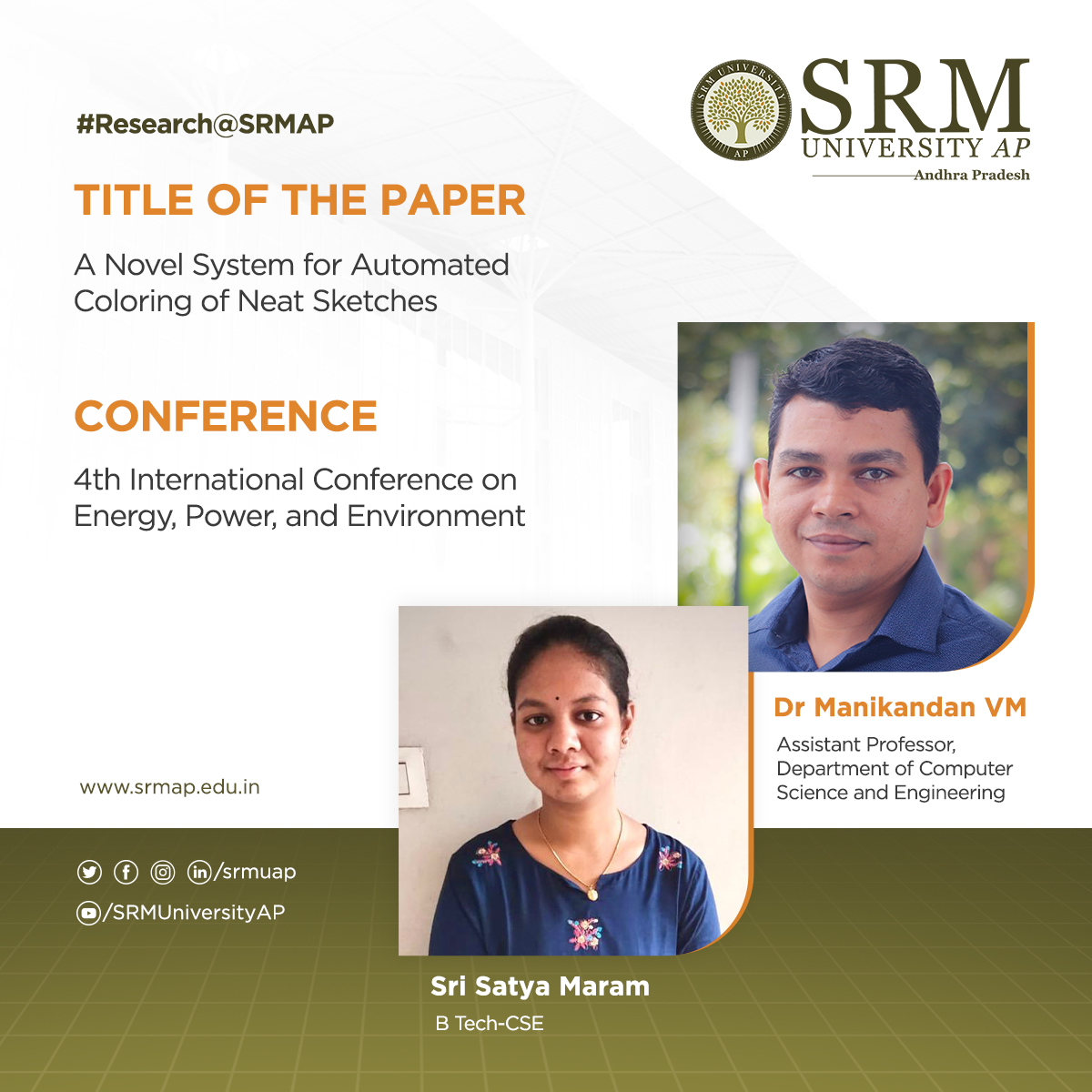 The paper presented by second year BTech CSE student Sri Satya Maram is titled A Novel System for Automated Coloring of Neat Sketches and was co-authored by Dr V M Manikandan. The research introduces a new algorithm to colour a given neat sketch. The proposed algorithm can be used to colour drawings to create animated movies or to colour the designs developed by the designers. The researchers plan to develop artistic features on the coloured image for better visual appearance.
The paper presented by second year BTech CSE student Sri Satya Maram is titled A Novel System for Automated Coloring of Neat Sketches and was co-authored by Dr V M Manikandan. The research introduces a new algorithm to colour a given neat sketch. The proposed algorithm can be used to colour drawings to create animated movies or to colour the designs developed by the designers. The researchers plan to develop artistic features on the coloured image for better visual appearance.Explanation of the research
The process of colouring neat sketches is a significant activity when making animated movies or for better visualization in computer modelling. The colour filling tools are widely available in almost all the image/video editing software, which will help us pick a colour from a colour palette and can be filled in a selected region. This process is known as flat colouring. The flat colouring process has several challenges. One of the significant challenges is that the colour may leak from the selected regions to neighbouring regions if there are some small openings on the contours. The second concern while using flat colouring is that the designated areas will be filled entirely with the same colour, so the drawing will not have an artistic look. The research proposes a new software application that will take a neat sketch as the input, and the system will generate a coloured drawing as the output. In the proposed scheme, the researchers have converted the given sketch to a grayscale or binary image and applied image dilation operation to fill the small open spaces in the contours (if any). Further, the closed regions are identified and coloured with a predefined set of colours or random colour combinations. While colouring the regions, the proposed system will ensure that the adjacent regions will not be coloured with the same colours. A number of sketches have been considered during the experimental study, and the results are validated manually.
Continue reading → - Computational intelligence and the healthcare system June 30, 2022
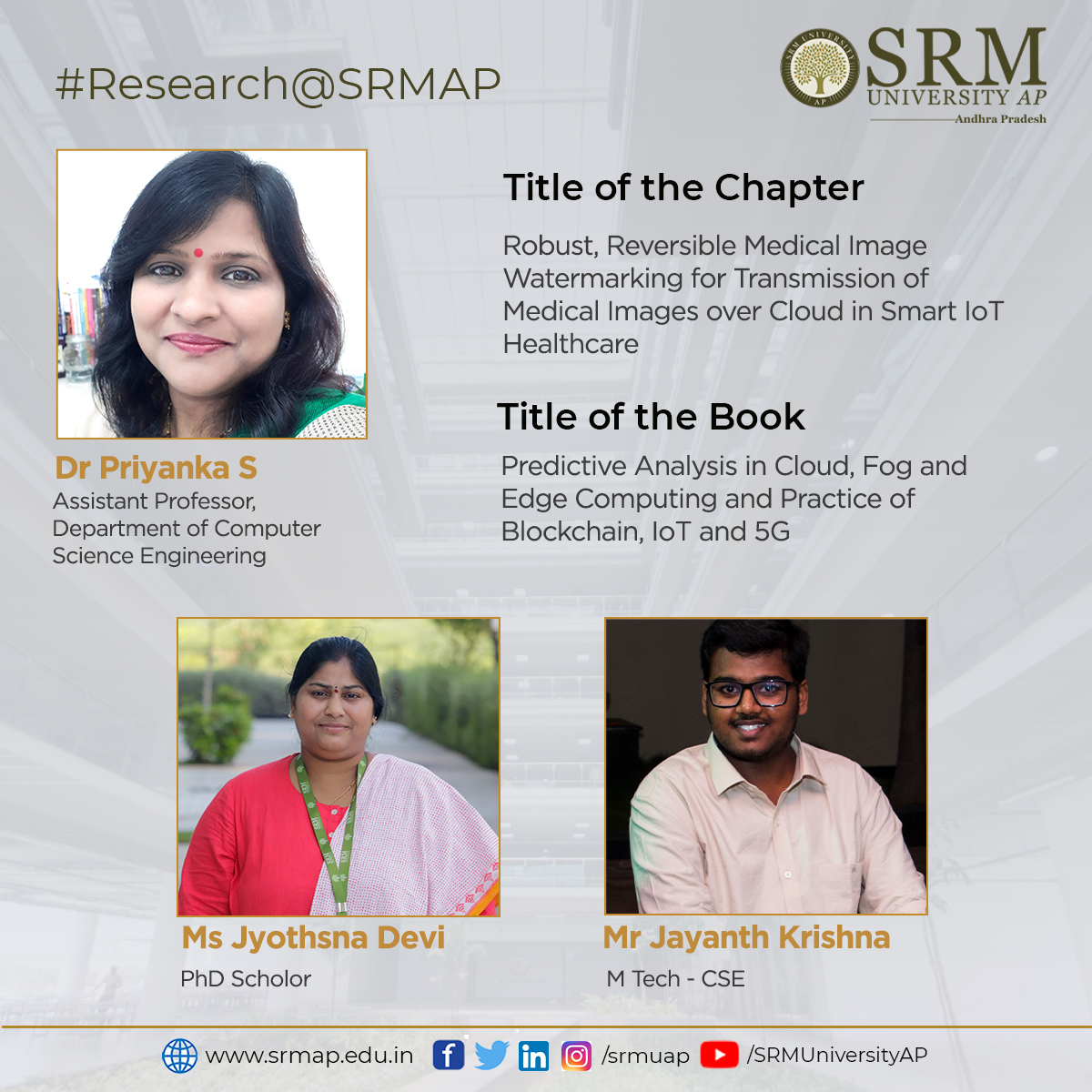 Computational and artificial intelligence is enjoying an unparalleled relevance in the modern world. They improve people’s lives and are highly anticipated in the healthcare industry. Research in this domain is hugely appreciated by the contemporary world, considering its potential to create revolutionary changes in the health care system. The Department of Computer Science and Engineering is delighted to inform you that the paper Robust, Reversible Medical Image Watermarking for Transmission of Medical Images over Cloud in Smart IoT Healthcare has been accepted for publishing as a chapter in the book Predictive Analysis in Cloud, Fog and Edge Computing and Practice of Blockchain, IoT and 5G.
Computational and artificial intelligence is enjoying an unparalleled relevance in the modern world. They improve people’s lives and are highly anticipated in the healthcare industry. Research in this domain is hugely appreciated by the contemporary world, considering its potential to create revolutionary changes in the health care system. The Department of Computer Science and Engineering is delighted to inform you that the paper Robust, Reversible Medical Image Watermarking for Transmission of Medical Images over Cloud in Smart IoT Healthcare has been accepted for publishing as a chapter in the book Predictive Analysis in Cloud, Fog and Edge Computing and Practice of Blockchain, IoT and 5G.The paper was submitted by Assistant Professor Dr Priyanka S, her PhD student Ms Jyothsna Devi, and MTech student Mr Jayant Krishna. The book chapter for the edited book is entitled Predictive Data Security using Ai – Insights and Issues of Blockchain, IoT, and DevOps and is published by Springer Nature. It is a part of the book series, Studies in Computational Intelligence, indexed by SCOPUS.
The book Studies in Computational Intelligence targets to bring together researchers and practitioners in computational intelligence and AI technology, especially those related to the areas of Machine learning, blockchain, multimedia using AI, smart IoT environment and email spam and online surveys, and many more recent emerging fields. The research work mainly provides highly secure, robust medical image transmission over the cloud in a smart IoT healthcare environment to ensure high embedding capacity and integrity.
This book’s target audience comprises professionals and researchers working in the field of computational intelligence and AI for health services in a smart environment. The book will attract Engineers (computer, industrial, software, and others), health care scholars, and information scientists since it caters to their interests.
Continue reading → - Paper accepted in the prestigious conference to be held in Caneda June 27, 2022
The research paper, An under complete autoencoder for denoising computational 3D sectional images from the Department of Electronics and Communication Engineering has been accepted in a prestigious conference called Imaging and Applied Optics Congress to be held in Vancouver, Canada 2022. Assistant Professors; Dr Sunil Chinnadurai, Dr Karthikeyan Elumalai, Dr Inbarasan Muiraj, and the PhD students; Ms Vineela Chandra Dodda and Ms Lakshmi Kuruguntla are the authors who contributed to composing the paper.
Abstract
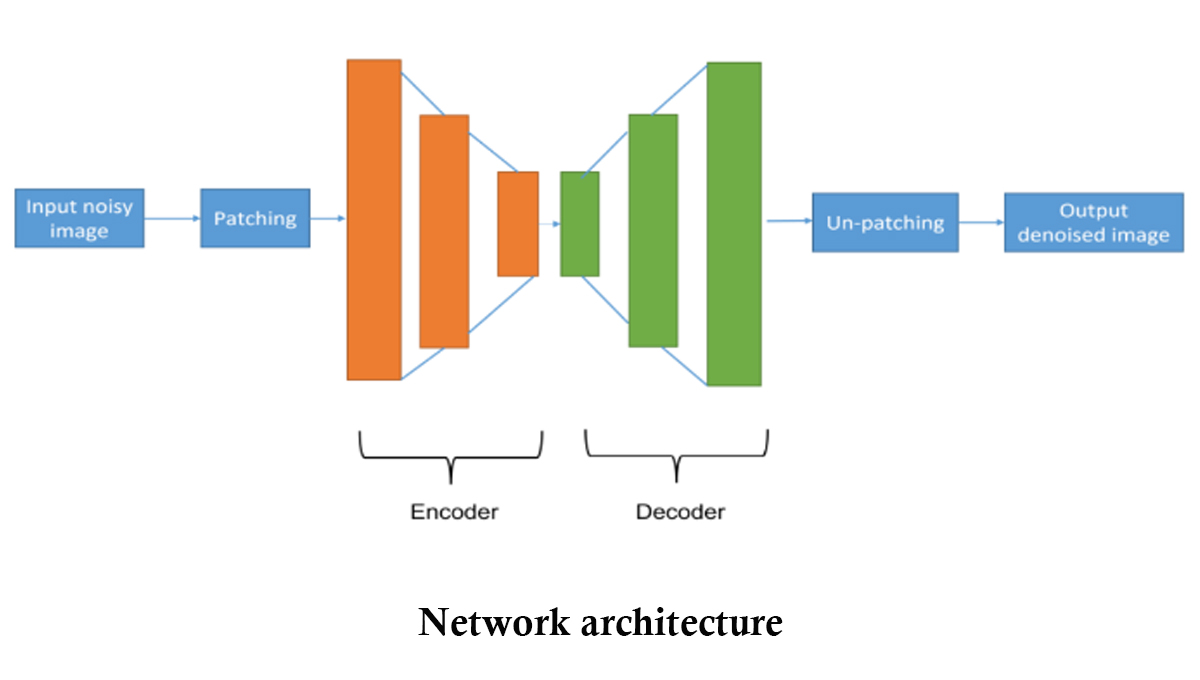 This paper proposes to use a deep-stacked under complete autoencoder to denoise the noisy 3D integral (sectional) images with a patch-based approach. In this process, the noisy input 3D sectional image is divided into multiple patches, which are then used to train the neural network. By using the patch-based approach, the time required to prepare the labeled training data is greatly reduced. Results demonstrate the feasibility of our proposed model in terms of the peak-signal-to-noise ratio.
This paper proposes to use a deep-stacked under complete autoencoder to denoise the noisy 3D integral (sectional) images with a patch-based approach. In this process, the noisy input 3D sectional image is divided into multiple patches, which are then used to train the neural network. By using the patch-based approach, the time required to prepare the labeled training data is greatly reduced. Results demonstrate the feasibility of our proposed model in terms of the peak-signal-to-noise ratio.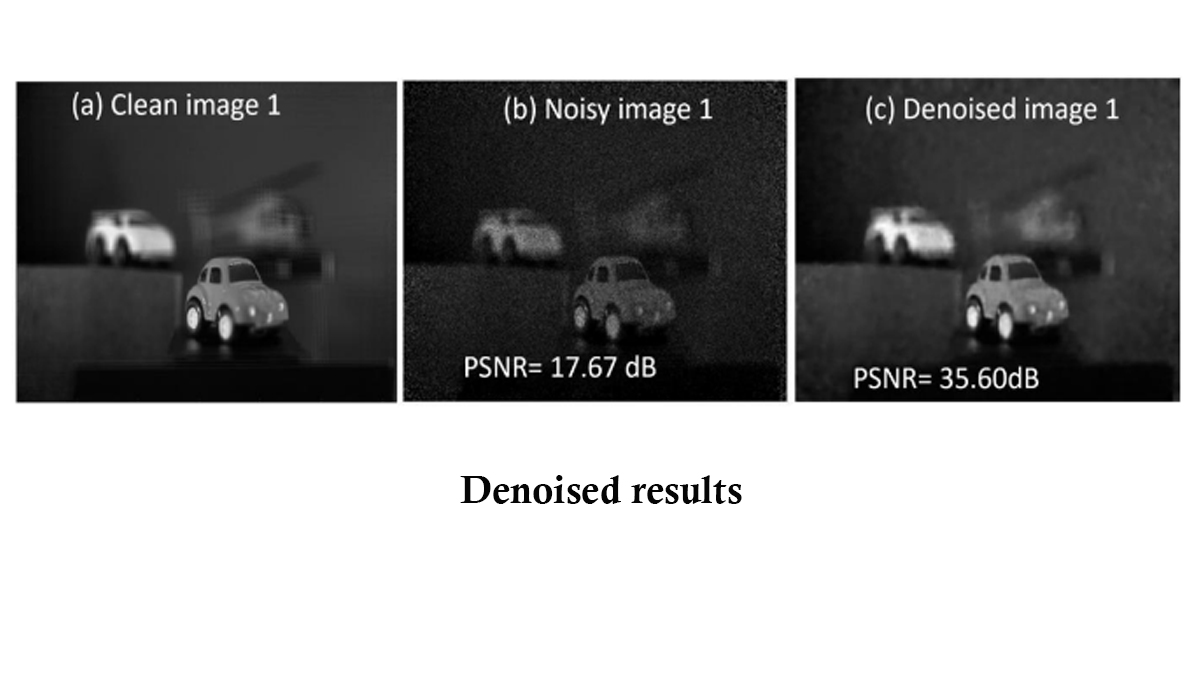 Explanation of the research
Explanation of the researchDenoising is one of the preliminary processes in image processing that removes noise from an image of interest and restores a clean image. The noise which was generated during the image acquisition process is attenuated using deep learning techniques. The denoised image is further used in various tasks of image processing.
In any image acquisition system, noise is inevitable and needs to be attenuated before further processing for qualitative results. The medical field is an example of this (images acquired through CT, MRI, PET, etc.). The researchers further investigate various techniques in deep learning to improve the denoising performance along with the applicability of deep learning in various tasks such as object recognition etc.
Continue reading →

